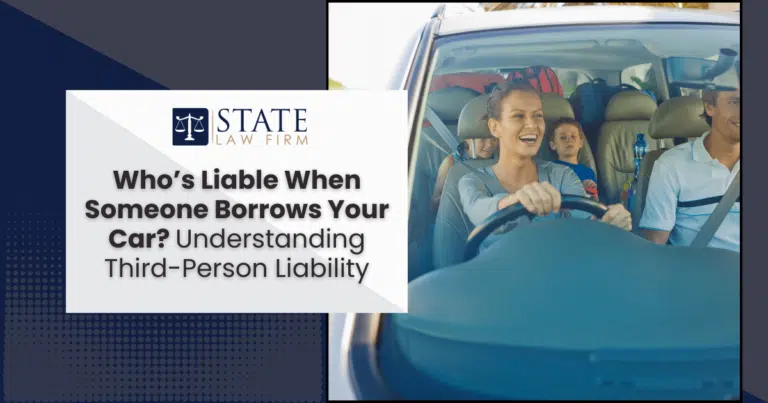Lending your car to a friend or family member is a common act of kindness. However, it’s essential to understand the potential legal implications if an accident occurs while someone else is behind the wheel of your vehicle. In 2023, approximately 40,999 people died in traffic crashes in the U.S., highlighting the importance of being informed about liability issues.
At State Law Firm, our team of dedicated Sherman Oaks car accident lawyers is committed to guiding you through the complexities of third-person liability in car borrowing situations. Our goal is to provide you with clear, comprehensive information to help you navigate these scenarios confidently.
In this article, we’ll explore who bears responsibility when someone else drives your car, delve into the nuances of insurance policies, examine the role of negligence, and discuss the importance of clear communication between car owners and borrowers. By understanding these aspects, you can make informed decisions and protect yourself and others on the road.
Introduction to Third-Person Liability in Car Borrowing Situations
Lending your car to a friend or family member might seem like a simple favor, but it can come with significant legal and financial consequences. If the borrower gets into an accident, determining liability isn’t always straightforward. Who is responsible for covering damages? Does insurance follow the car or the driver?
Understanding third-person liability in car borrowing situations is crucial for protecting yourself and ensuring you don’t end up financially or legally entangled in an unexpected lawsuit. Below, we break down the key aspects of third-person liability, from insurance implications to negligence laws and state-specific regulations.
The Basics of Borrowing a Car: Who is Responsible?
When someone borrows your car, responsibility for any accidents or damages typically depends on multiple factors, including the car owner’s insurance policy, the borrower’s driving record, and the circumstances of the accident.
Key Considerations:
- Car Owner Responsibilities: The registered owner of the vehicle is usually the first line of responsibility when an accident occurs. Most auto insurance policies follow the car rather than the driver.
- Borrower Liabilities: If the borrower causes an accident due to reckless driving, intoxication, or gross negligence, they may be personally liable for damages beyond insurance coverage.
- Insurance Coverage Implications: Standard auto insurance often provides primary coverage, meaning your policy may cover the damages first before the borrower’s insurance kicks in.
- Renting vs. Borrowing a Car: Rental car companies require separate insurance coverage, whereas borrowed cars fall under personal auto policies. Understanding the distinction can prevent costly surprises.
Pro Tip: Always verify that your auto insurance policy covers permissive drivers before allowing someone to borrow your car.
Understanding Insurance Policies and Their Impact on Liability
Auto insurance policies are the first line of defense when determining liability in an accident involving a borrowed vehicle. Knowing how different types of coverage apply is essential.
- Liability Coverage: This covers damages to other vehicles and injuries to third parties caused by the driver of your car.
- Collision Coverage: Pays for repairs to your vehicle if it is damaged in an accident, regardless of who was at fault.
- Comprehensive Insurance: Covers non-accident-related damages such as theft, vandalism, or natural disasters.
- Permissive vs. Non-Permissive Use: Most policies extend coverage to permissive drivers (those who have the owner’s consent), but claims may be denied if the borrower is excluded from the policy.
Pro Tip: If you frequently lend your car to the same person, consider adding them to your policy to avoid potential coverage disputes.
Complex Considerations:
- Third-Party Insurance: Third-party insurance protects you from claims made by others if the borrower causes an accident. This coverage can include bodily injury liability and property damage liability, which are required in most states.
- Subrogation: If your insurer pays for damages caused by a borrower, they may seek reimbursement from the borrower’s insurance company, which can complicate claims processing and liability determination.
- No-Fault States vs. At-Fault States: No-fault states require drivers to file claims with their insurer regardless of fault, whereas at-fault states require the liable party’s insurance to cover damages.
The Role of Negligence in Determining Liability When Borrowing a Vehicle
Negligence plays a crucial role in determining liability in car borrowing situations. If an accident occurs, proving who was negligent can impact financial responsibility.
- Duty of Care: Both the owner and the borrower must ensure the vehicle is operated safely.
- Proving Negligence: Liability may fall on the borrower if they were speeding, driving under the influence, or violating traffic laws.
- Vicarious Liability: In some cases, car owners can be held responsible for the borrower’s negligence, particularly if they knowingly lent their car to an irresponsible driver.
- Negligent Entrustment: If a car owner lends their vehicle to someone they know is unlicensed, intoxicated, or reckless, they may be held liable for damages.
Example: If you lend your car to someone with a history of reckless driving, and they cause an accident, you could be held partially liable for negligent entrustment.
State Laws and Regulations Affecting Car Borrowing Liability
Liability laws vary by state, so it’s important to understand local regulations that may impact responsibility when lending your vehicle.
- Vicarious Liability Statutes: Some states hold car owners responsible for damages caused by the borrower, regardless of fault.
- No-Fault vs. At-Fault States: In no-fault states, insurance covers damages regardless of who was at fault, whereas at-fault states determine responsibility based on negligence.
- State-Specific Insurance Requirements: Certain states require additional coverage for permissive drivers, which may affect your liability in an accident.
- Uninsured and Underinsured Motorist Coverage: If the borrower is involved in an accident with an uninsured or underinsured driver, your policy may need to cover damages, depending on state laws.
Pro Tip: Before lending your car, check your state’s laws on car borrowing liability to ensure you’re fully informed about potential risks.
The Importance of Clear Communication Between the Owner and the Borrower
Setting clear expectations before lending your car can prevent misunderstandings and legal complications down the road.
- Written Agreements: If you frequently lend your car to someone, consider drafting a simple written agreement outlining the terms of use.
- Verbal Agreement Risks: While verbal agreements are common, they can lead to disputes if an accident occurs and liability is questioned.
- Understanding Expectations: Make sure the borrower knows the limits of your insurance coverage and agrees to take financial responsibility for any damages not covered.
Pro Tip: Never lend your car to someone you don’t fully trust to drive safely and responsibly. If in doubt, say no.
Protect Yourself Before Lending Your Car
While lending your car to a friend or family member may seem like an act of goodwill, it comes with significant legal and financial risks. Understanding how liability, insurance policies, and state laws apply can help you make informed decisions before handing over your keys.
At State Law Firm, our team of experienced Sherman Oaks car accident lawyers is here to help you navigate complex liability issues. If you or a loved one are facing legal challenges related to car borrowing accidents, contact us today for expert legal guidance tailored to your situation.


